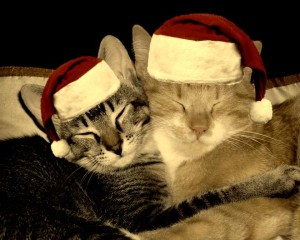 The holidays are approaching and its time to go shopping! Around this time of year people come to That Fish Place – That Pet Place to begin scoping out pet possibilities for their kids. Nothing would please a little boy or girl more than to open up a box on Christmas morning to find that Santa has left them a real live animal for being so good all year! But what Santa (and parents!) need to remember is that an animal should be treated differently than most presents. Here is a checklist I’ve composed for prospective live gift givers to review before presenting a pet as a gift.
The holidays are approaching and its time to go shopping! Around this time of year people come to That Fish Place – That Pet Place to begin scoping out pet possibilities for their kids. Nothing would please a little boy or girl more than to open up a box on Christmas morning to find that Santa has left them a real live animal for being so good all year! But what Santa (and parents!) need to remember is that an animal should be treated differently than most presents. Here is a checklist I’ve composed for prospective live gift givers to review before presenting a pet as a gift.
Is it OK with Mom and Dad?
Countless times right after Easter and Christmas I see animals being returned or surrendered to us because “Aunt Shirley” decided it would be nice to present her nephew with a living surprise without checking to see if it was OK with his family first. Most of the time, this happens because Mom and Dad simply were not ready or willing to take care of an animal they hadn’t been expecting. Although Aunt Shirley meant well, she should have discussed it with her nephew’s parents to make sure they also wanted a new pet to feed and care for in their house. Doing this would have spared everyone a lot of heartaches and headaches!
Have you done your research?
Never buy an animal on a whim and expect its young owner to know just what to do. Read, go online, and talk to employees at the pet store to make sure you are picking the right animal for your child and that you will be able to give it everything it needs to be happy and healthy.
Will the child be able to properly care for this animal?
 Very young children may promise they will do all the work, but let’s face it; the job usually falls to Mom or Dad. Make sure the child will take an active role in the care of their pet before giving them one for Christmas, and make sure Mom and Dad won’t mind picking up the slack.
Very young children may promise they will do all the work, but let’s face it; the job usually falls to Mom or Dad. Make sure the child will take an active role in the care of their pet before giving them one for Christmas, and make sure Mom and Dad won’t mind picking up the slack.
Do you have a plan for the animal before Christmas Day?
Animals cannot be kept in the box they came home in from the pet store all night long. Most of them will chew their way out before morning or their urine will possibly burn a hole through the box or cause them to get respiratory problems from breathing in the fumes all night. If you decide to pick up the animal on Christmas Eve or sooner, make sure you have a cage or a temporary set-up complete with food, water, and shelter until Christmas morning.
Did you put holes in the box?
This may seem obvious, but I have heard painful stories of animals being found suffocated after only a few minutes in an airtight box. If you are going to wrap the cage or box with the animal in it at the last minute before the child wakes up Christmas morning, be sure there are breathing holes in the box.
Do you have all the supplies ready along with the new pet?
Nothing is worse than opening up a new toy and realizing there are no batteries included with it. The same goes for a new pet. What good is your pet gerbil if you can’t put him in his new cage and watch him play right away! Be prepared to gift a cage, accessories, food, and bedding along with the new pet.
Do you have a “Safe Zone” for the new pet?
Holidays are hectic stressful times for pets and people alike, and it will be much worse for a brand new animal in a brand new home. Once the excitement has worn down over the opening of the live gift, place the animal in its cage and move it to a “safe zone” — a quiet room where friends, relatives, and other pets will not be able to bother it. It may be tempting for your child to parade around showing Grandma and Grandpa the new bunny she’s gotten, but for the bunny, this is a very scary experience! The best way to make a good impression on a new pet is to respect its boundaries and give it time to adjust to a new home. Save show-and-tell for another day, when the animal has had more time to adjust to his new home.
Have you considered gifting the supplies first?
Since the holidays are so hectic, it’s a good idea to buy the cage and accessories first and have your child open these on Christmas morning instead of a box with a live animal in it. First of all, this will keep things from getting too crazy what with setting up the animal in its cage and keeping intrigued relatives at bay. Second of all, this will extend the excitement for the child because now she has a chance to pick out her new animal and can look forward to going to the pet store the next day to get her REAL gift! And then she gets to pick out what she likes best without you having to guess which color or personality type she would prefer beforehand.
Will you commit to the gift?
This happens more with rabbits and chicks over Easter, but I’ve seen it happen with other animals at Christmas too. Sometimes families believe it is okay to get their son or daughter a baby animal to raise for a while with plans to get rid of it as soon as it is older or the weather gets nice. I have a big problem with this! First of all, you cannot always guarantee to find a home for your adult animal when you are ready to get rid of it and sadly, this sometimes results in animals being released into the wild or dumped on a farm somewhere. Secondly, this is teaching children that once something becomes too big, old, or expensive to care for, it is okay to abandon it. Owning a pet throughout its entire life is an educational and enriching experience that will help children learn about life and responsibility. If you plan on getting your kids a pet for Christmas, be prepared to care for that animal until the day it dies. Pets need proper housing, food, and veterinary care, and if you ever find yourself in a predicament that makes it impossible to continue providing these things for your animal make sure you have a suitable plan to re-home that animal with someone who can. Pets are not temporary. They are for life.
With all this in mind, try to enjoy preparing to bring a new pet into the family at Christmas time. Planning ahead will make things much easier, and it can be a warming experience to see that look in your child’s eye one he or she realizes you finally said yes to that pet they’ve been wanting so bad! Adding a new member to the family is a wonderful experience if done properly, so be smart, be safe, and always keep the animal’s best interests in mind. Happy Holidays!
 That Pet Blog That Pet Place Pet Blog
That Pet Blog That Pet Place Pet Blog








